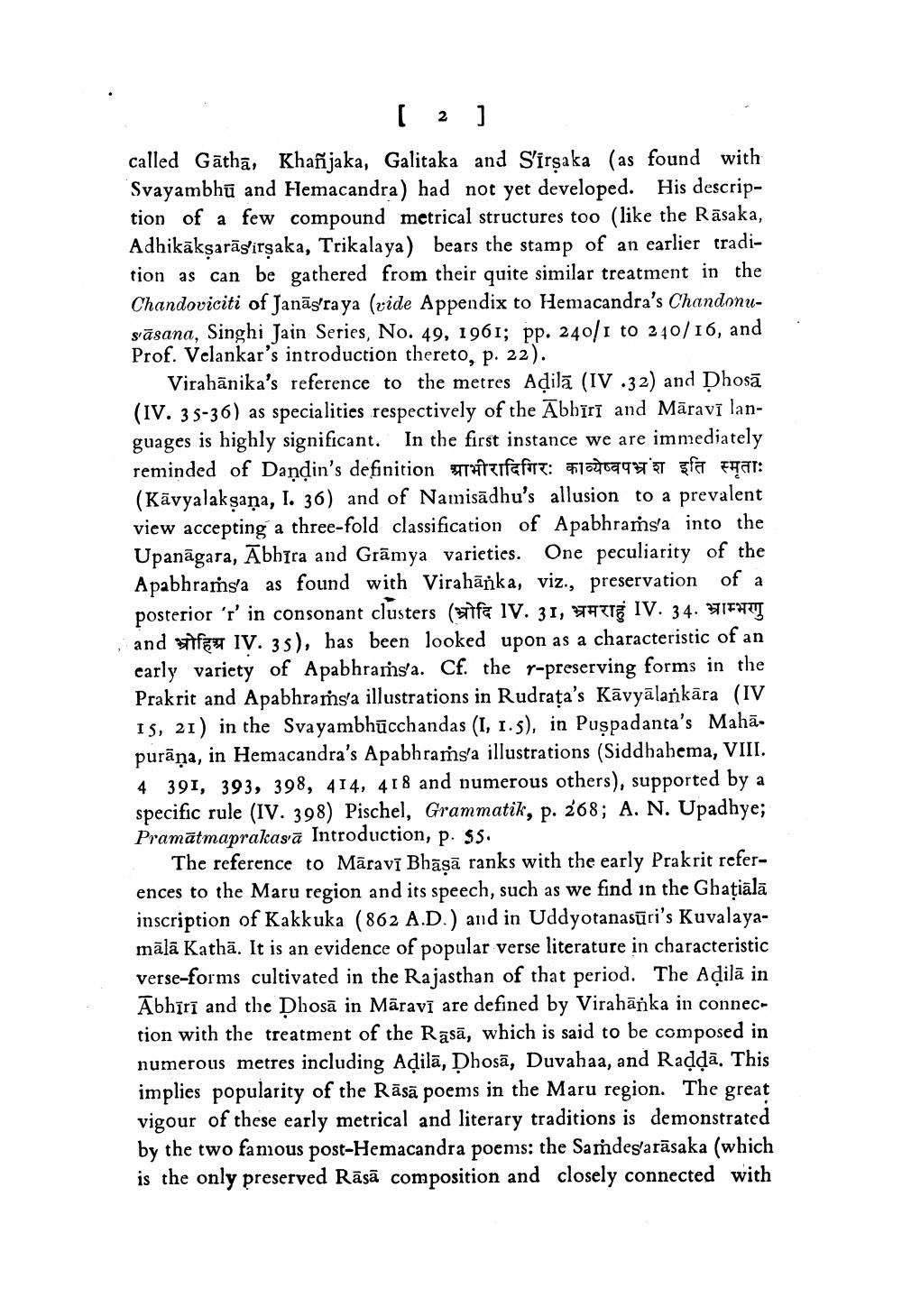Book Title: Vruttajatisamucchaya Author(s): H D Velankar Publisher: Rajasthan Prachyavidya Pratishtan View full book textPage 9
________________ [ 2 ] called Gātha, Khañjaka, Galitaka and S'irşaka (as found with Svayambhū and Hemacandra) had not yet developed. His description of a few compound metrical structures too (like the Rāsaka, Adhikākṣarāg'irşaka, Trikalaya) bears the stamp of an earlier tradition as can be gathered from their quite similar treatment in the Chandoviciti of Janās'raya (vide Appendix to Hemacandra's Chandonusvāsana, Singhi Jain Series, No. 49, 1961; pp. 240/1 to 240/16, and Prof. Velankar's introduction thereto, p. 22). Virahānika's reference to the metres Adilā (IV.32) and Dhosā (IV. 35-36) as specialities respectively of the Abbīrī and Māravī languages is highly significant. In the first instance we are immediately reminded of Dandin's definition auttifefort: F100099y gfa Fhar: (Kāvyalakşaņa, I. 36) and of Namisādhu's allusion to a prevalent view accepting a three-fold classification of Apabhraṁsa into the Upanāgara, Ābhīra and Grāmya varieties. One peculiarity of the Apabhraṁsa as found with Virahāňka, viz., preservation of a posterior 'r' in consonant clusters (wife IV. 31, E IV. 34. IFHTU and wifeu IV. 35), has been looked upon as a characteristic of an early variety of Apabhraṁs'a. Cf. the r-preserving forms in the Prakrit and Apabhraís'a illustrations in Rudrata's Kāvyālańkāra (IV 15, 21) in the Svayambhūcchandas (I, 1.5), in Puspadanta's Mahā. purāņa, in Hemacandra's Apabhrams'a illustrations (Siddhahema, VIII. 4 391, 393, 398, 414, 418 and numerous others), supported by a specific rule (IV. 398) Pischel, Grammatik, p. 268; A. N. Upadhye; Pramātmaprakasā Introduction, p. s The reference to Māravī Bhāṣā ranks with the early Prakrit references to the Maru region and its speech, such as we find in the Ghațiālā inscription of Kakkuka (862 A.D.) and in Uddyotanasūri's Kuvalayamālā Kathā. It is an evidence of popular verse literature in characteristic verse-forms cultivated in the Rajasthan of that period. The Adilā in Ābhīrī and the Dhosā in Māravī are defined by Virahārka in connection with the treatment of the Rāsā, which is said to be composed in numerous metres including Adilā, Dhosā, Duvahaa, and Raddā. This implies popularity of the Rāsā poems in the Maru region. The great vigour of these early metrical and literary traditions is demonstrated by the two famous post-Hemacandra poems: the Saṁdesarāsaka (which is the only preserved Rāsā composition and closely connected withPage Navigation
1 ... 7 8 9 10 11 12 13 14 15 16 17 18 19 20 21 22 23 24 25 26 27 28 29 30 31 32 33 34 35 36 37 38 39 40 41 42 43 44 45 46 47 48 49 50 51 52 53 54 55 56 57 58 59 60 61 62 63 64 65 66 67 68 69 70 71 72 73 74 75 76 77 78 79 80 81 82 83 84 85 86 87 88 89 90 91 92 ... 194
